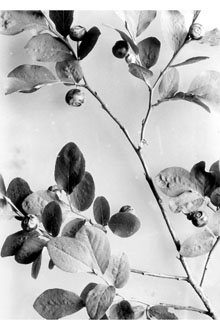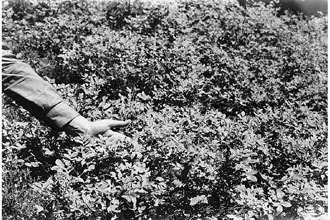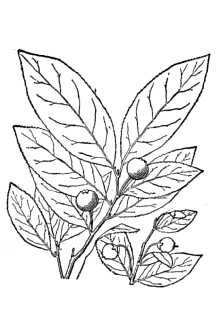Vaccinium membranaceum Douglas ex Torr. var. rigidum (Hook.) Fernald
Scientific Name: Vaccinium membranaceum Douglas ex Torr. var. rigidum (Hook.) Fernald

| General Information | |
|---|---|
| Usda Symbol | VAMER |
| Group | Dicot |
| Life Cycle | Perennial |
| Growth Habits | Shrub |
| Native Locations | VAMER |
Plant Guide
Alternate Names
Thinleaf huckleberry
Uses
Ethnobotanic: The nlaka'pamux of British Columbia, the Okanagan-Colville and Nez Perce of eastern Washington, the Plateau Indians of the Columbia River Gorge, the Kootenay of southeastern British Columbia, and the Flathead people of Montana (among others) really savored the black huckleberries (Turner et al. 1990; Hunn 1990; Hart 1976). Traditionally, black huckleberry fruits were eaten raw and fresh, or were cooked, mashed, and dried in the sun as cakes. The Nez Perce boiled the dried berries before they were eaten. The Stoney (Assiniboin) sometimes mixed the berries in pemmican. Okanagan-Colville people used the ripening of black hawthorn fruits (Crataegus douglasii Lindl.) as an indicator of when black huckleberries would be ripe in the mountains. They ate huckleberries fresh with meat; partially dried them, crushed them and formed them into cakes; or fully dried them. In British Columbia, the Kwakwaka'wakw cooked them with salmon roe and the Sechelt smoke-dried them, using black huckleberry branches as part of the fuel. A first fruits ceremony or feast is held by many nations in the Pacific Northwest, including the Columbia Plateau Indians, the Umatilla, the Yakima, the Warm Springs, and the Colville Confederated Tribes. Huckleberry feasts are held in July or August, coinciding with the first berry harvest. A thanksgiving ceremony is held at this time, with gratitude expressed through prayer, dancing, and celebration. Feasts used to also be given at a girl's first berry picking or root gathering and at the first procuring of game by a boy. These generally occurred when the child was ten years old. At these feasts, they served food procured by the child along with other foods. The elders praised and blessed the work of the child, giving the child the power to become great and successful later in life. Used with permission of the publishers © Stanford University Abrams & Ferris (1960) After the huckleberry feast, the Sahaptin people of the Columbia Plateau would leave for a seasonal migration to the mountains to gather berries and to escape the summer heat. Special baskets, called "Klikitat baskets" of cedar root decorated with bear grass and bitter cherry bark, were used for berry picking. The surplus berries were dried slowly over a fire that was kept smoldering in a rotten log (Filloon 1952). This method of drying the berries preserves the bulk of the Vitamin C content in the fruits (Norton et al. 1984:223). Each family from the Columbia Plateau area would gather four or five pecks (ca. four to five gallons) of dried berries for winter use (Perkins n.d. (1838-43), Book 1:10). Hunn (1990) estimates that there were 28-42 harvest days in a year. This resulted in a total annual harvest of 63.9-80.2 kg/woman/year from the Tenino-Wishram area, and 90 kg/woman/year from the Umatilla area. The net result was a huckleberry harvest yield of 31 kcal/person/day in the Tenino-Wishram area and 42 kcal/person/day for the Umatilla area (Hunn 1981: 130-131). Vaccinium species contain 622 Kcal per 100 gm berries, with 15.3 gm carbohydrate, 0.5 gm fat, 0.7 gm protein and 83.2 gm water (Hunn 1981:130-131). Huckleberries are used for a lavender or purple natural dye in the twined corn husk bags made by the Nez Perce; the cornhusks are dyed with the juice of the berries. The Nlaka'pamux sometimes used the leaves in smoking mixture (Turner 1990). Other Uses: Vaccinium membranaceum is the most highly regarded of the huckleberry species within its range, especially in British Columbia and neighboring areas (Turner 1975, 1978). People of all cultures love these huckleberries. Today, the berries are eaten fresh, baked in pancakes, pies, and muffins, canned, frozen, or made into jams and jellies. Berries are usually picked in late July or August. The leaves can be used fresh or dried to make a tea. Huckleberry leaves and finely chopped stems contain quinic acid, a former therapeutic for gout said to inhibit uric acid formation but never widely used because of mixed clinical results (Moore 1979). The leaves have been widely used to lower or modify blood sugar levels, particularly in Europe. Taken on regular basis, huckleberry tea will gradually help alleviate both glycosuria and hyperglycemia and has a benign but useful effect as an adjunct treatment to diabetes mellitus. Wildlife: Huckleberry fruits are an important food source for songbirds, gulls, cranes, pigeons, turkeys, and upland game birds. Many mammals, from black bears to mice, feed on red huckleberries. Herbivores graze on the entire plant; it appears to be a favorite browse of deer. Huckleberries and blueberries form a major part of the grizzly and black bear's diet in late summer and fall. Grouse feast on the leaves and blossoms. The fruits, twigs, and foliage are eaten by foxes, opossums, raccoons, squirrels, deer, moose, caribou, elk, pikas, cottontail rabbits, and skunks.
Status
Please consult the PLANTS Web site and your State Department of Natural Resources for this plant’s current status, such as, state noxious status, and wetland indicator values.
Description
General: Huckleberry Family (Ericaceae). Black huckleberry is an erect, deciduous shrub 0.1-2 m tall. The leaves, up to 5 cm long, are elliptical with a long pointed tip and a finely serrated margin. The bell-shaped flowers are creamy-pink, and are found singly on the underside of the twigs. The berries are large, spherical, sweet, and dark purple or black. In some forms the berries are covered with a waxy bloom; others have shiny dark berries. Distribution: For current distribution, please consult the Plant Profile page for this species on the PLANTS Web site. Black huckleberry is found in thickets and on Montana slopes in coniferous woods at elevations from 1000-1800 m. It grows in sandy or gravelly soils, ranging from moist to dry growing conditions. Vaccinium membranaceum grows from British Columbia to Alberta and Ontario, north to the Mackenzie Delta area, south to California in the Klamath Range and North Coast Range, and east to Michigan.
Establishment
Black huckleberry requires moist and acidic soils to become established, Vaccinium membranaceum is very difficult to establish, Cuttings: Take cuttings from rhizomes in early spring or late summer and autumn, Dig up the rhizomes and cut them into lengths of 10 cm or longer, Place the cuttings in vermiculite at 21 °C, Use soil moisture sensors to measure the soil moisture of Vaccinium membranaceum Douglas ex Torr. var. rigidum (Hook.) Fernald., Once the roots are established and meristematic activity is initiated, the small cuttings may be moved to individual pots with a peat:sand soil mixture (1:1) potting soil, The soil should be kept fairly moist, When plants are the size desired, plant in soils that are fairly acidic, or add the peat-sand mixture to the soil before planting, Plants must be kept well watered to become established, Plants establish well in partial shade, Seeds: Collect the berries in the fall and clean by running them through a blender with dull blades, straining the pulp with a sieve, and spreading them to dry on a paper towel, Most authors believe that the seeds require no stratification or scarification (Haeussler et al, 1990; Link 1993; Minore and Smart 1978), However, Albright (1996) found poor germination without stratification and recommends over-wintering of seeds in flats outside, Seeds germinate within 16-21 days of sowing, Germination percentages can be improved by sowing the seed on moist peat in a growth chamber at 18° C (for 12 hours a day) and 13° C (for 12 hours a day), Seven weeks after germination warm the growth chamber to 20 ° C (for 14 hours a day) and 14° C (for 10 hours a day), Fertilize the seedlings after they are 10 weeks old and transplant into a peat-sand soil mixture (1:1) in individual pots after 12 weeks (Minore and Smart 1978), The soil should be kept fairly moist,
Management
Huckleberry plants grow very rapidly in moist, shady conditions. If summer drought occurs, the plants should be watered so roots are kept fairly moist. Traditional Resource Management: Management of this plant includes the following: 1) occasional burning to stimulate new growth; 2) pruning the branches after picking the berries to stimulate new growth and fruit production the next growing season; and 3) ownership of black huckleberry shrubs provides the basis for careful tending and sustainable yield of valued resources. Cultivars, Improved and Selected Materials (and area of origin) This species is available at some native plant nurseries within its range. Contact your local Natural Resources Conservation Service (formerly Soil Conservation Service) office for more information. Look in the phone book under ”United States Government.” The Natural Resources
Conservation
Service will be listed under the subheading “Department of Agriculture.”
References
Abrams, L & R.S. Ferris 1960. Illustrated flora of the Pacific states. 4 Vols. Stanford University Press, Palo Alto, California. Albright, M. 1996. Greenhouse Manager. USDI, National Park Service, Olympic National Park, Port Angeles, Washington. Personal communication. Cooke, S. S. 1997. A field guide to the common wetland plants of western Washington and northwestern Oregon. Seattle Audubon Society and Washington Native Plant Society. 414 pp. Crossley, J.A. 1974. Vaccinium L. blueberry. Pages 840-843, IN: Shopmeyer, C.S. (tech. coord.) Seeds of the woody plants in the United States. USDA, FS, Agric. Handbook 450. Washington, D.C. 883 pp. Dirr, M.A. & C.W. Heuser, Jr. 1987. The reference manual of woody plant propagation: From seed to tissue culture. Varsity Press, Athens, Georgia. 329 pp. Filloon, R. M. 1952. Huckleberry pilgrimage. Pacific Discovery 5(3):4-13. Gunther, E. 1945 rev. 1973. Ethnobotany of western Washington. University of Washington Publications in Anthropology, 10(1). University of Washington Press, Seattle, Washington. Haeussler, S., D. Coates, & J. Mather 1990. Autecology of common plants in British Columbia: A literature review. British Columbia Ministry of Forests. 272 pp. Harbinger, L. J. 1964. The importance of food plants in the maintenance of Nez Perce cultural identity. Master of Arts in Anthropology. Washington State University, Pullman, Washington. 73 pp. Hickman, J. C. (ed.) 1993. The Jepson manual. Higher plants of California. University of California Press, Berkeley, California. 1399 pp. Hitchcock, C. L. & A. Cronquist 1973 . Flora of the Pacific Northwest. An illustrated manual. University of Washington Press, Seattle and London. 730 pp. Hunn, E. S. 1990. Nch'i-Wana "The Big River" Mid-Columbia Indians and their land. University of Washington Press, Seattle and London. 378 pp. Hunn, E. S. 1981. On the relative contribution of men and women to subsistence among hunter-gatherers of the Columbia Plateau: A comparison with ethnographic atlas summaries. J. of Ethnobiology 1:124-34. Isaacson, R. T. 1993. Anderson horticultural library's source list of plants and seeds. Anderson Horticultural Library. University of Minnesota Libraries. Minnesota Landscape Arboretum. 261 pp. Kunlein, H.V. a& N. J. Turner 1991. Traditional plant foods of Canadian indigenous peoples. Nutrition, botany, and use. Food and nutrition in history and Anthropology Volume 8. Gordon and Breach Science Publishers. 632 pp. Leigh, M.A. 1997. Grow your own native landscape: A guide to identifying, propagating, and landscaping with western Washington native plants. Environmental Protection Agency, The Washington State Department of Ecology, and Washington State University Cooperative Extension. Link, E. (ed.) 1993. Native plant propagation techniques for national parks: Interim guide. USDA, NRCS, Rose Lake Plant Material Center, East Lansing, Michigan. 240 pp. Minore, D. & A.W. Smart 1978. Frost tolerance in seedlings of Vaccinium membranaceum, Vaccinium globulare, and Vaccinium deliciosum. Northwest Science 52(3):179-185. Moore, M. 1979. Medicinal plants of the mountain west. Museum of New Mexico Press, Albuquerque, New Mexico. 200 pp. Moser, C. L. 1993. Native American basketry of Southern California. Riverside Museum Press, Riverside, California. 155 pp. Norton, H.H., E.S. Hunn, C.S. Martinsen, & P.B. Keely 1984. Vegetable food products of the foraging economies of the Pacific Northwest. Ecology of Food and Nutrition 14:219-228. Rose, R., C.E.C. Chachulski, & D. Haase 1998. Propagation of Pacific Northwest native plants. Oregon State University Press, Corvallis, Oregon. Stevens, M.L. & R. Vanbianchi 1993. Restoring wetlands in Washington. A guidebook for wetland restoration, planning and implementation. Washington State Department of Ecology, Publication #93-17, Olympia, Washington. Turner, N.J., L.C. Thompson, M.T. Thompson & A.Z. York 1990 . Thompson ethnobotany: Knowledge and usage of plants by the Thompson Indians of British Columbia. Royal British Columbia Museum Memoirs No. 3, Victoria, British Columbia, Canada. Turner, N.J., J. Thomas, B.F. Carlson & R.T. Ogilvie 1983 . Ethnobotany of the Nitinaht Indians of Vancouver Island. British Columbia, Provincial Museum Occasional Paper No. 24, 165 pp. Turner, N.J. & B.S. Efrat 1982 Ethnobotany of the Hesquiat Indians of Vancouver Island. British Columbia, Provincial Museum Cultural Recovery Paper No. 2. 99 pp. Turner, N.J. 1978. Food plant of British Columbia Indians. Part II. Interior Peoples. British Columbia Provincial Museum Handbook No. 36, Victoria, British Columbia, Canada. Turner, N.J. 1975. Food plants of British Columbia Indians. Part I. Coastal Peoples. British Columbia Provincial Museum Handbook No. 34. Victoria, British Columbia, Canada. Vanbianchi, R., M.L. Stevens, T. Sullivan & S. Hashisaki 1994. A citizen's guide to wetland restoration. U.S. EPA, Region 10, Seattle, Washington. 71 pp.
Plant Traits
Growth Requirements
| Temperature, Minimum (°F) | -38 |
|---|---|
| Adapted to Coarse Textured Soils | Yes |
| Adapted to Fine Textured Soils | No |
| Adapted to Medium Textured Soils | Yes |
| Anaerobic Tolerance | Low |
| CaCO3 Tolerance | None |
| Cold Stratification Required | Yes |
| Drought Tolerance | Low |
| Fertility Requirement | Low |
| Fire Tolerance | High |
| Frost Free Days, Minimum | 85 |
| Hedge Tolerance | Low |
| Moisture Use | Low |
| pH, Maximum | 5.6 |
| pH, Minimum | 4.5 |
| Planting Density per Acre, Maxim | 2700 |
| Planting Density per Acre, Minim | 1700 |
| Precipitation, Maximum | 50 |
| Precipitation, Minimum | 10 |
| Root Depth, Minimum (inches) | 12 |
| Salinity Tolerance | None |
| Shade Tolerance | Intermediate |
Morphology/Physiology
| Bloat | None |
|---|---|
| Toxicity | None |
| Resprout Ability | Yes |
| Shape and Orientation | Semi-Erect |
| Active Growth Period | Spring and Summer |
| C:N Ratio | Medium |
| Coppice Potential | No |
| Fall Conspicuous | No |
| Fire Resistant | No |
| Flower Color | Purple |
| Flower Conspicuous | Yes |
| Foliage Color | Green |
| Foliage Porosity Summer | Moderate |
| Foliage Porosity Winter | Porous |
| Foliage Texture | Medium |
| Fruit/Seed Conspicuous | Yes |
| Nitrogen Fixation | None |
| Low Growing Grass | No |
| Lifespan | Long |
| Leaf Retention | No |
| Known Allelopath | No |
| Height, Mature (feet) | 4.5 |
| Height at 20 Years, Maximum (fee | 4 |
| Growth Rate | Moderate |
| Growth Form | Multiple Stem |
| Fruit/Seed Color | Black |
Reproduction
| Vegetative Spread Rate | Slow |
|---|---|
| Small Grain | No |
| Seedling Vigor | Low |
| Fruit/Seed Period Begin | Spring |
| Seed Spread Rate | Slow |
| Propagated by Tubers | No |
| Propagated by Sprigs | No |
| Propagated by Sod | No |
| Propagated by Seed | Yes |
| Propagated by Cuttings | Yes |
| Propagated by Container | Yes |
| Propagated by Bulb | No |
| Propagated by Bare Root | Yes |
| Fruit/Seed Persistence | No |
| Fruit/Seed Period End | Summer |
| Fruit/Seed Abundance | Medium |
| Commercial Availability | Contracting Only |
| Bloom Period | Late Spring |
| Propagated by Corm | No |
Suitability/Use
| Veneer Product | No |
|---|---|
| Pulpwood Product | No |
| Post Product | No |
| Palatable Human | Yes |
| Palatable Graze Animal | Low |
| Palatable Browse Animal | Medium |
| Nursery Stock Product | No |
| Naval Store Product | No |
| Lumber Product | No |
| Fodder Product | No |
| Christmas Tree Product | No |
| Berry/Nut/Seed Product | Yes |



